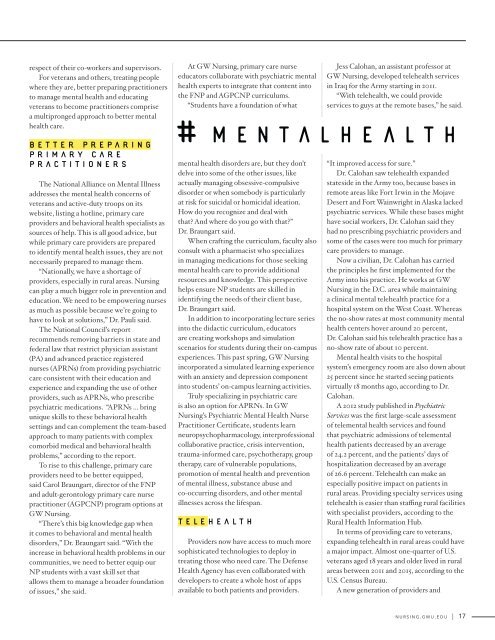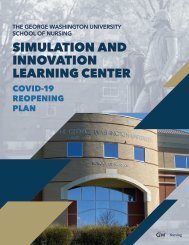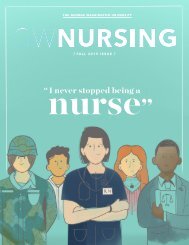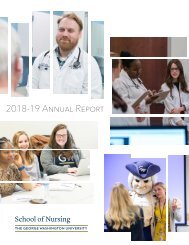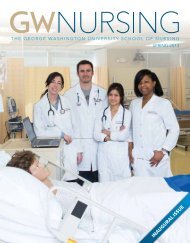GW Nursing Magazine Fall 2018
GW Nursing is a publication of the George Washington University School of Nursing. The magazine tells the story of GW nurses and their endeavors in the areas of education, research, policy and practice.
GW Nursing is a publication of the George Washington University School of Nursing. The magazine tells the story of GW nurses and their endeavors in the areas of education, research, policy and practice.
Create successful ePaper yourself
Turn your PDF publications into a flip-book with our unique Google optimized e-Paper software.
espect of their co-workers and supervisors.<br />
For veterans and others, treating people<br />
where they are, better preparing practitioners<br />
to manage mental health and educating<br />
veterans to become practitioners comprise<br />
a multipronged approach to better mental<br />
health care.<br />
better preparing<br />
primary care<br />
practitioners<br />
The National Alliance on Mental Illness<br />
addresses the mental health concerns of<br />
veterans and active-duty troops on its<br />
website, listing a hotline, primary care<br />
providers and behavioral health specialists as<br />
sources of help. This is all good advice, but<br />
while primary care providers are prepared<br />
to identify mental health issues, they are not<br />
necessarily prepared to manage them.<br />
“Nationally, we have a shortage of<br />
providers, especially in rural areas. <strong>Nursing</strong><br />
can play a much bigger role in prevention and<br />
education. We need to be empowering nurses<br />
as much as possible because we’re going to<br />
have to look at solutions,” Dr. Pauli said.<br />
The National Council’s report<br />
recommends removing barriers in state and<br />
federal law that restrict physician assistant<br />
(PA) and advanced practice registered<br />
nurses (APRNs) from providing psychiatric<br />
care consistent with their education and<br />
experience and expanding the use of other<br />
providers, such as APRNs, who prescribe<br />
psychiatric medications. “APRNs ... bring<br />
unique skills to these behavioral health<br />
settings and can complement the team-based<br />
approach to many patients with complex<br />
comorbid medical and behavioral health<br />
problems,” according to the report.<br />
To rise to this challenge, primary care<br />
providers need to be better equipped,<br />
said Carol Braungart, director of the FNP<br />
and adult-gerontology primary care nurse<br />
practitioner (AGPCNP) program options at<br />
<strong>GW</strong> <strong>Nursing</strong>.<br />
“There’s this big knowledge gap when<br />
it comes to behavioral and mental health<br />
disorders,” Dr. Braungart said. “With the<br />
increase in behavioral health problems in our<br />
communities, we need to better equip our<br />
NP students with a vast skill set that<br />
allows them to manage a broader foundation<br />
of issues,” she said.<br />
At <strong>GW</strong> <strong>Nursing</strong>, primary care nurse<br />
educators collaborate with psychiatric mental<br />
health experts to integrate that content into<br />
the FNP and AGPCNP curriculums.<br />
“Students have a foundation of what<br />
Jess Calohan, an assistant professor at<br />
<strong>GW</strong> <strong>Nursing</strong>, developed telehealth services<br />
in Iraq for the Army starting in 2011.<br />
“With telehealth, we could provide<br />
services to guys at the remote bases,” he said.<br />
# m e n t a l h e a l t h<br />
mental health disorders are, but they don’t<br />
delve into some of the other issues, like<br />
actually managing obsessive-compulsive<br />
disorder or when somebody is particularly<br />
at risk for suicidal or homicidal ideation.<br />
How do you recognize and deal with<br />
that? And where do you go with that?”<br />
Dr. Braungart said.<br />
When crafting the curriculum, faculty also<br />
consult with a pharmacist who specializes<br />
in managing medications for those seeking<br />
mental health care to provide additional<br />
resources and knowledge. This perspective<br />
helps ensure NP students are skilled in<br />
identifying the needs of their client base,<br />
Dr. Braungart said.<br />
In addition to incorporating lecture series<br />
into the didactic curriculum, educators<br />
are creating workshops and simulation<br />
scenarios for students during their on-campus<br />
experiences. This past spring, <strong>GW</strong> <strong>Nursing</strong><br />
incorporated a simulated learning experience<br />
with an anxiety and depression component<br />
into students’ on-campus learning activities.<br />
Truly specializing in psychiatric care<br />
is also an option for APRNs. In <strong>GW</strong><br />
<strong>Nursing</strong>’s Psychiatric Mental Health Nurse<br />
Practitioner Certificate, students learn<br />
neuropsychopharmacology, interprofessional<br />
collaborative practice, crisis intervention,<br />
trauma-informed care, psychotherapy, group<br />
therapy, care of vulnerable populations,<br />
promotion of mental health and prevention<br />
of mental illness, substance abuse and<br />
co-occurring disorders, and other mental<br />
illnesses across the lifespan.<br />
telehealth<br />
Providers now have access to much more<br />
sophisticated technologies to deploy in<br />
treating those who need care. The Defense<br />
Health Agency has even collaborated with<br />
developers to create a whole host of apps<br />
available to both patients and providers.<br />
“It improved access for sure.”<br />
Dr. Calohan saw telehealth expanded<br />
stateside in the Army too, because bases in<br />
remote areas like Fort Irwin in the Mojave<br />
Desert and Fort Wainwright in Alaska lacked<br />
psychiatric services. While these bases might<br />
have social workers, Dr. Calohan said they<br />
had no prescribing psychiatric providers and<br />
some of the cases were too much for primary<br />
care providers to manage.<br />
Now a civilian, Dr. Calohan has carried<br />
the principles he first implemented for the<br />
Army into his practice. He works at <strong>GW</strong><br />
<strong>Nursing</strong> in the D.C. area while maintaining<br />
a clinical mental telehealth practice for a<br />
hospital system on the West Coast. Whereas<br />
the no-show rates at most community mental<br />
health centers hover around 20 percent,<br />
Dr. Calohan said his telehealth practice has a<br />
no-show rate of about 10 percent.<br />
Mental health visits to the hospital<br />
system’s emergency room are also down about<br />
25 percent since he started seeing patients<br />
virtually 18 months ago, according to Dr.<br />
Calohan.<br />
A 2012 study published in Psychiatric<br />
Services was the first large-scale assessment<br />
of telemental health services and found<br />
that psychiatric admissions of telemental<br />
health patients decreased by an average<br />
of 24.2 percent, and the patients’ days of<br />
hospitalization decreased by an average<br />
of 26.6 percent.Telehealth can make an<br />
especially positive impact on patients in<br />
rural areas. Providing specialty services using<br />
telehealth is easier than staffing rural facilities<br />
with specialist providers, according to the<br />
Rural Health Information Hub.<br />
In terms of providing care to veterans,<br />
expanding telehealth in rural areas could have<br />
a major impact. Almost one-quarter of U.S.<br />
veterans aged 18 years and older lived in rural<br />
areas between 2011 and 2015, according to the<br />
U.S. Census Bureau.<br />
A new generation of providers and<br />
nursing.gwu.edu | 17


